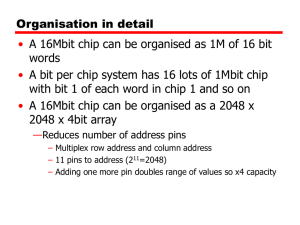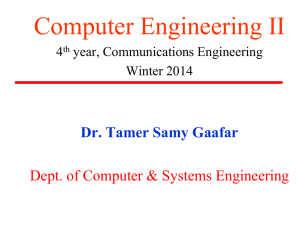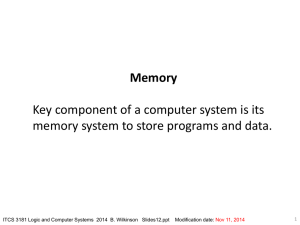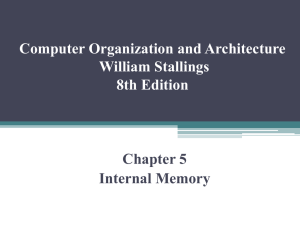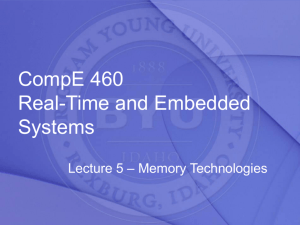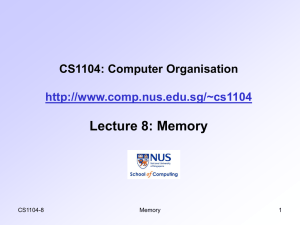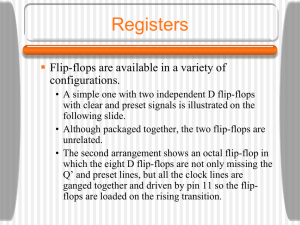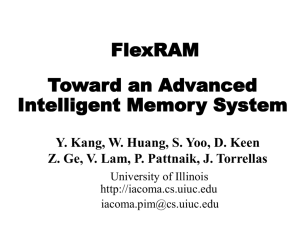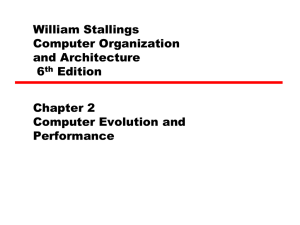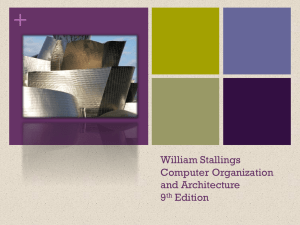Lecture 14 - MemoryOrganization2
advertisement
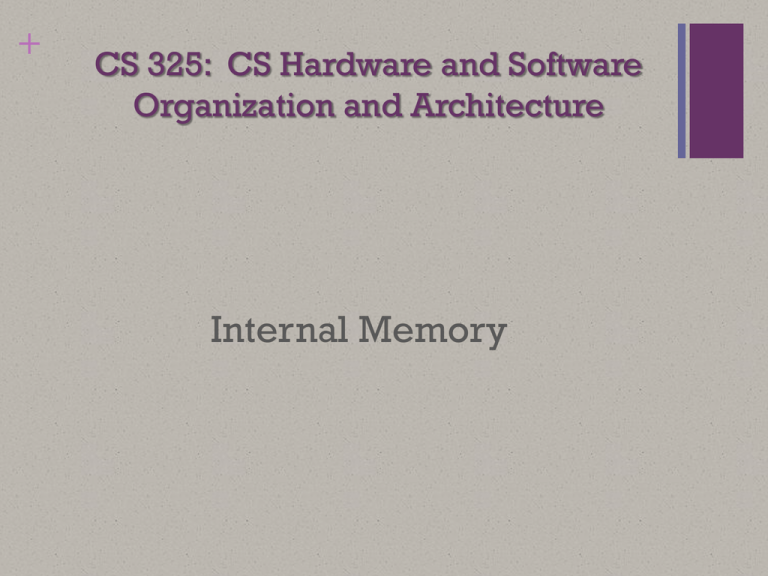
+ CS 325: CS Hardware and Software Organization and Architecture Internal Memory + Semiconductor Main Memory Early computer used doughnut shaped ferromagnetic loops called cores for storing each bit. This main memory was often referred to as “core memory” or just “core”. Some terms still exist: “core dump” Semiconductors are almost universal today. + Memory Cells Properties: Includes two stable or semi-stable states representing 1 and 0. Capable of being written to at least once to set state. Capable of being read to sense the state. + Memory Cell Operation Select line selects cell for operation specified by control line. Control line has read or write signal. Data/Sense line captures current state, or creates new state. + Semiconductor Memory Types + Semiconductor Memory RAM (Random Access Memory) Misnamed as all semiconductor memory is “random access” Read and write abilities Volatile Time required to access any address is constant and does not depend on previous address accessed. Temporary storage Two technologies: Dynamic RAM: Analog device, uses capacitor to store charge. Static RAM: Digital device, uses flip-flop logic gates to store state. + Dynamic RAM (DRAM) Bits stored as charge in capacitors Capacitor charge will leak, resulting in the need of a refresh circuit. Simpler construction that static RAM Used for main memory. Essentially analog rather than digital. Level of capacitor charge determines logic value of memory cell. + Dynamic RAM Structure + DRAM Operation Address line active when bit read or written. Write Transistor switch closed (current flows) Voltage is applied to bit line High for 1, low for 0 Then address line is activated Transistor allows current to flow; transfers charge to the capacitor. Read Address line is activated Transistor allows current to flow; transfers charge from capacitor to the bit line. Bit line fed to sense amplifier Compares with reference value to determine 0 or 1. Capacitor charge must be restored to complete the read operation. + Static RAM (SRAM) Digital device that uses the same logic elements as the CPU. Binary values are stored using traditional flip-flop logic gate configurations. No charges to leak No refresh needed when powered More complex construction – 6 transistors Larger and more expensive per bit, but faster than DRAM Used as Cache + Static RAM Structure + SRAM Operation Transistor arrangement gives stable logic state. State 1: C1 high, C2 low T1, T4 off; T2, T3 on State 0: C2 high, C1 low T2, T3 on; T1, T4 off Address line transistors T5 and T6 form a switch. Write – apply value to B and complement of B. Read – value is on line B + SRAM Vs DRAM Both are volatile Power needed to preserve data Dynamic cells Simpler to build and smaller than SRAM Therefore more dense and less expensive Needs refresh circuitry Favored for larger memory units Static cells Faster than DRAM More expensive to build Favored for cache memory + All of the Acronyms So what is SDRAM? Synchronous DRAM SDR SDRAM “Single Data Rate” DDR SDRAM “Double Data Rate” DDR2 2x memory transfer bandwidth DDR3 4x memory transfer bandwidth DDR4 8x memory transfer bandwidth (under development) RDRAM Rambus DRAM And many more acronyms… + Read Only Memory (ROM) Permanent, nonvolatile storage Contains a permanent pattern of data that cannot be changed or added to No power source required to maintain bit values Data is actually wired into the chip as a part of the fabrication process Disadvantages: No room for error. If one bit is wrong, whole batch of ROMs must be thrown out + Read-mostly memory Read “mostly” memories can be rewritten Erasable Programmable (EPROM) Optical erasure of entire chip by UV light Can take up to 20 minutes to erase Only one transistor per bit Electrically Erasable (EEPROM) Takes much longer to write than read Several hundred microseconds Can rewrite single bytes Less dense than EPROM + Flash Memory Provides block electrical erasure but not byte level Typical block size 512, 2048, 4096 High density One transistor per bit Fast read speeds, but not as fast as DRAM Very slow erase speed + Chip Logic Trade-offs in chip design among speed, capacity, and cost Key issue is number of bits that can be written simultaneously One extreme: Physical arrangement of memory cells same as logical arrangement of words in memory 16Mbit chip is 1M 16-bit word Other extreme: One bit per chip, 16M memory uses 16M 1-bit chips + Organization in detail A 16Mbit (2MB) chip can be organized as a 2048 x 2048 x 4bit array Reduces number of address pins Multiplex row and column address 11 pins to address (211 = 2048) Adding one more pin doubles range (212 = 4096) + Refreshing Refresh circuit included on chip Disable chip Count through rows Read and write back Refresh takes time Slows down performance + Chip Packaging + 1 MB EPROM Packaging Organized as 1M 8 bit words, 32 pins A0 – A19 address pins (20 bit address) D0 – D7 data pins Power supply at Vcc and ground at Vss CE chip enable pin Indicates whether read/write address valid for this chip Could be several chips Vpp programming voltage pin used in write operations + 16 Mbit DRAM Organized as 4Mx4 bits Data pins D1-D4 are input/output WE (write enable) and OE (output enable) determine if read or write occurs RAS (row address select) and CAS (column address select) pins 2 Vcc and Vss pins One NC (no connect) to make even number of pins + Error Detection and Correction Hard Failure Permanent defect Caused by Harsh environmental abuse Manufacturing defects Wear Soft Error Random, non-destructive No permanent damage to memory Caused by Power supply problems + Error Detection and Correction A single parity bit can be used to detect (most) errors in a word Parity bit test can fail to detect errors when there is more than one bit error Hamming codes can be used to detect and correct errors
